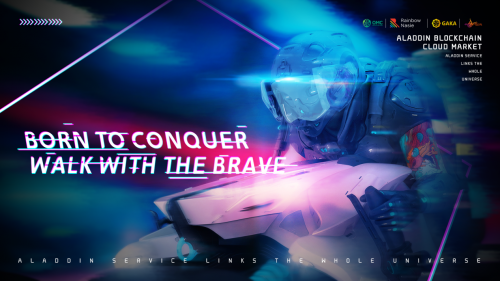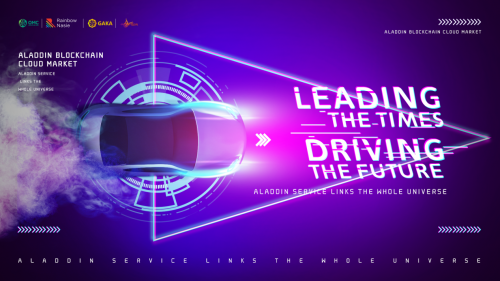2022-03-04
Looking back at the development of the information technology market in the past few decades, we can see that every major market cycle follows the same rules and continues to develop, namely: the cycle of decentralization, expansion, and consolidation.
Maybe many people have heard the stories about Web3.0 and know some slogans about Web3.0, but they don't know the meaning and development behind it. Here, we try to share with you more comprehensively and interestingly the business theories and laws in the era of Web3.0 distributed economy. Perhaps after we understand these, we can understand why an ecology like Aladdin is of great significance.

Human society has experienced three eras: the agricultural era, the industrial era, and the Internet era.
Corresponding to three kinds of relationships: the relationship between man and nature, the relationship between man and products, and the relationship between man and soul!
In the era of farming, we deal with the relationship between man and nature, asking for wood from the mountains and forests, and crops from the fields.
In the industrial age, we create some products, we deal with the relationship between people and products. The desires of human beings have been stimulated unprecedentedly. In order to meet the various needs of people, technological innovation has led to unprecedented prosperity of various industries, and various products have emerged one after another. Oversupply, people are overwhelmed by constantly upgrading products.
In the Internet age, with abundant products, we have satisfied our basic physiological needs and began to pursue higher-level spiritual needs. Therefore, the Internet was born, and the virtual space with technology as the carrier began to develop. At this time, spiritual needs began to determine material needs.
Therefore, business has changed from "things gather together" to "people divide by groups". The former traditional, narrow and multi-link supply chain is transformed into a point-to-point, personalized and customized direction. Those traditional production, marketing, channels and profit models have all changed, and traditional economic theories and business models have all failed! What will the future be like?

1. In the era of excess product, a new order is taking shape
The biggest feature of this era is that the old order is being completely destroyed, while the new order is thriving!
In terms of business, the biggest change is that the traditional supply chain is being replaced by a new supply chain, and a new business civilization is being formed, which is like the reverse opening of water flowing to a high place.
The traditional supply chain consists of suppliers, manufacturers, distributors, retailers, and consumers, which is a long and narrow chain structure. This is the traditional wholesale model, and it is also a top-down apportionment approach: manufacturers need to sell their products to distributors, distributors to retailers, and finally to consumers. Each downstream link must first spend money to get the goods from the upstream link, and the quantity of goods received in each link is required. The more goods you get, the lower the discount.
This not only produces profit exploitation, but also reduces the operational efficiency layer by layer. Since the sales volume of products in each link is certain, the part of products beyond the digestibility becomes inventory, which is distributed in each link layer by layer.
"Inventory" is a big black hole that eats away business profits.
More importantly: in the age of material scarcity, as long as you can produce a product, it will be enjoyed by consumers. But now is the era of overcapacity, material products are already abundant, and consumers have more and more choices.
With the cooperation of the Internet, consumers' vision has doubled, and their needs have become more and more personalized and diversified. Brands and styles tend to be more, newer and faster.
However, this kind of complicated and long supply chain cannot sense the latest needs of consumers in a timely manner, let alone make quick responses, and is still producing blindly and disorderly, resulting in the accumulation of a large number of useless products.
Therefore, this traditional production mode must be eliminated!
Therefore, businessmen in the traditional production mode are also suffering!
2. Business has shifted from "clustering things together" to "dividing people into groups"
The essence of "Internet celebrity economy" is an art of aggregating consumers
When consumers have more and more initiative, those who can aggregate consumers and perceive their needs will appear. They can not only gather a large number of consumers (fans), but also cooperate with fans to customize products to manufacturers.
This is the current consumption relationship: what consumers need, producers have to produce. This is a process of reverse production, and the intermediate distribution and marketing links have been crossed, and the traditional long and narrow supply chain has become reverse and flat. Yes, this is the existing supply chain system represented by the "net red economy".
The essence of the "Internet celebrity economy" is an art of aggregating consumers, which means that business is changing from "clustering things together" to "dividing people into groups". Due to the retrograde movement of the supply chain, those traditional production, marketing, channels and profit models have all changed, and traditional economic theories and business models have all failed!

We must interpret the new business from a new perspective
In fact, the "Internet celebrity economy" is just an introduction and a phenomenon. From the perspective of new retail, this phenomenon reflects a strong demand of the society: the massive personalized demand has increased sharply, and the massive personalized customized products are being used. need! This is the general trend of business change!
Just as NFT paintings sold for $69.346 million at auction, this is a new carrier and new model spawned by new technologies.
In the past, if a market had a scale of 1 billion, it might be composed of 50 customers and 10 manufacturers. In the future, as the generation born after 2000 gradually becomes the main consumer, the 1 billion market will be composed of 20,000 customers and their 20,000 needs and 20,000 individual suppliers. Therefore, even if the total market size does not expand, there are still a lot of personalized needs to be provided!
3. Aladdin interprets the future "business experience"
The logic of business transformation is actually the projection of the development of the entire society.
Openness, sharing, personalization and customization are the general trend of social development.
From a macro perspective, this is a supply chain “disruption” that is rewriting existing business rules.
From a micro perspective, this new type of supply and demand relationship will surely set off a liberation of personality and demand, and even the realization of personal value!
In the end, we will be delighted to find that the result of our bottom-up supply and demand change is to make society more free, diverse, equal and inclusive, and a new personalized supply and demand relationship requires a new personalized supply chain, supply Platform to achieve, and Aladdin will work with global individual suppliers through the underlying support of blockchain technology, with NFT as the carrier, in this infinitely fertile era of blockchain economy, use a new perspective and method to interpret what belongs to you. new business.

Aladdin Creates Emerging Business Models
In the Web 3.0 era, Aladdin will rely on the underlying technology of the blockchain and the NFT form as the carrier to create an ecological platform for all users that links the decentralized capital of merchants all over the world.
Aladdin's goal is to link the world's Internet proletariat and build a metaverse of co-construction, sharing, mutual assistance, mutual benefit, flow, circulation, innovation, and entrepreneurship.